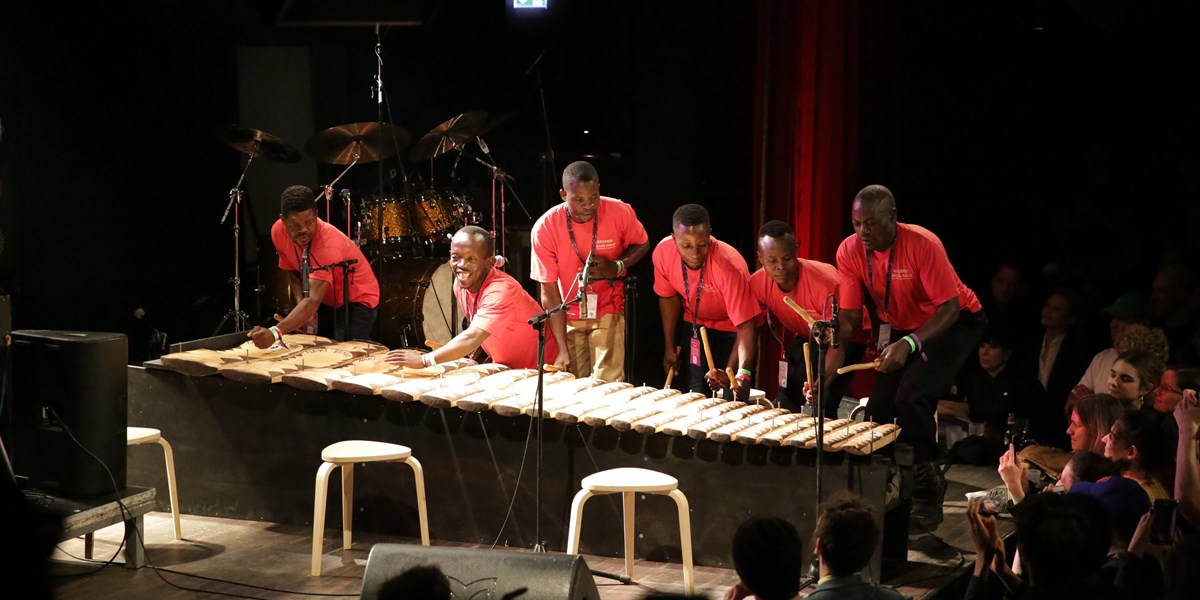Friday, June 10, 2022
Pit Bosses: Nakibembe Xylophone Troupe
By Jim Hickson
With keys sat on banana stems across a 50cm-deep hole dug into the ground, the embaire looks as extraordinary as it sounds. Jim Hickson navigates the mysteries of this unique multi-manned instrument from the Ugandan village of Nakibembe

Nakibembe Xylophone Troupe live at the CTM Festival, 2020 ©Stefanie Kulisch
There’s a worn-out cliché of a proverb that says ‘it takes a village to raise a child.’ In the Ugandan kingdom of Busoga, it takes one to play a xylophone. The instrument is the embaire, and the village of Nakibembe is world-renowned for its musicians’ prowess.
The embaire is huge. It is three metres long and its 21 keys are played by six musicians. Each performer plays a relatively simple repeating pattern across three or four keys, but multiplied six-fold, they create an intense battery of ever-evolving interlocking sonic shapes.
From this dense tangle of sound, distinct melodies, basslines and rhythms emerge, each musician’s abstract part combining into an entrancing whole. “It’s a bit like jazz,” explains Nassar Kinobi, the singer and bass-keys-specialist in the Nakibembe Xylophone Troupe.
“Everyone is playing a different thing, but there is always a connection between them. And there are things we can’t explain, it’s like magic. When we start playing, there is momentum. Anything can change and become a perfect part of a pattern, even if it’s an accident!”
The instrument itself is a feat of carpentry. The keys of the embaire are made from the wood of the omusambya (Nile tulip), and its beaters are made from the wood of the nzo (Teclea nobilis). The omusambya wood is carefully hewn with a special axe-chisel called the eyiga; the tuning is incredibly precise – each small chip of a giant key is an irreparable alteration – and measured entirely by ear.
When played in the villages of Busoga, the keys are laid on banana stems and placed over a 50cm-deep hole dug into the ground. This trough provides a booming resonance that enhances the instrument’s bass keys, connecting the embaire to the land of its ancestors in a very literal way.
It also makes it a challenge to set up on a stage. But with multiple international appearances under their belt, the Nakibembe Xylophone Troupe have found a way around that challenge. Each time they travel abroad, a specially-built box is commissioned to stand in for the earthen pit. The original keys from Nakibembe are then placed upon the new resonator, creating a hybrid instrument: half-Soga, half-international.
The Nakibembe Xylophone Troupe don’t just carry the name of their village out of sentimentality; the group is interwoven with the community itself. They are more than six musicians. In fact, they’re more like a football team. They have their ‘starting line-up,’ who are usually the ones who tour abroad, but there are many other players in the troupe who can sub in whenever necessary – the village even has a youth ensemble for trainees.
Arising in the 1970s, the giant 21-keyed version of the embaire is a fairly modern innovation on an ancient instrument, but it’s already a valuable tradition in Nakibembe.
“It’s become something big, and we want to keep it going,” says Rashidi Ngobi. Affectionately referred to as ‘the old man,’ Ngobi is the troupe’s elder, and the one who holds the embaire’s history. “If we teach people, and then they teach people, then it lives on because our ancestors did the same thing.
My job is to inspire the young generation and to make sure that I leave something for them. When they have children, they should teach them the same thing and keep the legacy going.”
Behind the intricate melodies and rhythms interlaced into a complex cacophony lies a simple truth. “The embaire was created to help take away sorrow, to bring joy and to make people forget their suffering. Its history is about people coming together and creating something for a cause,” says Ngobi.
With an instrument this big, it really does take a village.
This feature originally appeared in the June 2022 issue of Songlines magazine. Never miss an issue – subscribe today

